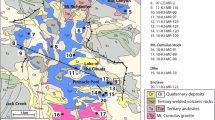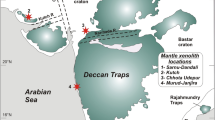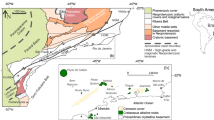Abstract
Spinel-bearing peridotitic mantle xenoliths from the 1949 eruption on La Palma were modified mineralogically and chemically during prolonged reaction with their host magma. The magmatism that brought the peridotites to the surface caused two distinct generations of xenolith fractures: (1) Old fractures are characterized by crystalline selvages with cumulus textures towards the host magma, or by polymineralic veins. They are accompanied by 0.9–2 mm wide diffusion zones where peridotite olivine became less forsteritic through diffusive exchange with the host magma. Old fractures represent most of each xenolith's surface. (2) Young fractures show no selvages and only narrow diffusion zones of <0.02 mm width. Calculations based on a model of Fe-Mg interdiffusion give an age of 6 to 83 years and <4 days for old and young fractures, respectively. A combination of these data with fluid inclusion barometry indicates that selvages and veins formed during xenolith transport rather than representing wall-rock reactions or mantle metasomatism. The results provide ample evidence for prolonged storage of the xenoliths in the crust, constraining a multi-stage magma ascent: Years to decades prior to eruption, ascending magma ruptured peridotitic wall-rock possibly through hydraulic fracturing and stoping around magma reservoirs. Magma batches transported the peridotite xenoliths to the crust at ascent rates exceeding 0.2 ms−1. The xenoliths and their host magma stagnated during at least 6 years in possibly sill-like reservoirs at 7–11 km depth. The xenoliths became deposited and subsequently embedded in a mush of settled phenocrysts, while selvages and veins crystallized until the eruption commenced. At the end of the eruption, the xenoliths were finally transported to the surface within hours to days. Decompression during the rapid ascent induced internal stresses and caused renewed fragmentation of the xenoliths, producing the young fractures.
Similar content being viewed by others
Author information
Authors and Affiliations
Additional information
Received: 25 August 1997 / Accepted: 25 November 1997
Rights and permissions
About this article
Cite this article
Klügel, A. Reactions between mantle xenoliths and host magma beneath La Palma (Canary Islands): constraints on magma ascent rates and crustal reservoirs. Contrib Mineral Petrol 131, 237–257 (1998). https://doi.org/10.1007/s004100050391
Issue Date:
DOI: https://doi.org/10.1007/s004100050391




